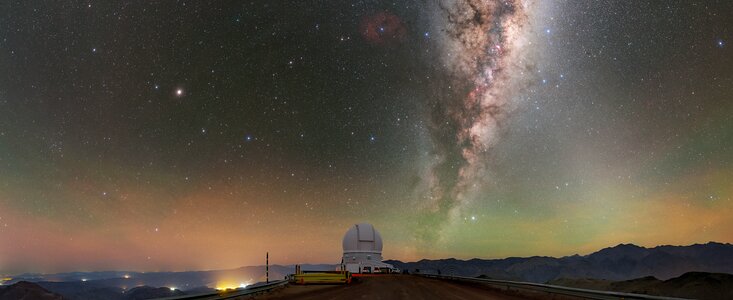Nueva norma lumínica en Chile preservará los cielos nocturnos en todo el país
La nueva Norma Lumínica en Chile reducirá la contaminación lumínica al imponer reglamentación más rigurosa en fuentes emisoras de luz
30 Octubre 2023
El 18 de octubre de 2023 se emitió una nueva norma lumínica en Chile para proteger los cielos oscuros y diáfanos del país, los cuales son valorados por diversas infraestructuras astronómicas del mundo, incluyendo a NOIRLab de NSF. La nueva norma, establecida por el Ministerio de Medio Ambiente de Chile, amplía el decreto existente establecido en 2012, con el objetivo de preservar la calidad astronómica de los cielos nocturnos en las Regiones de Antofagasta, Atacama y Coquimbo.
La nueva Norma Lumínica, formalmente denominada Decreto Supremo N° 1 de 2022, es una revisión del Decreto Supremo N° 43 de 2012 que amplía el ámbito de las cláusulas sobre fuentes emisoras de luz a todo el territorio de Chile. Asimismo, no sólo protege los cielos nocturnos para las observaciones astronómicas, sino que incorpora la protección de la biodiversidad y la salud humana como objetivos medioambientales.
La nueva Norma Lumínica incluye normativa sobre la luminosidad del alumbrado industrial, y establece límites a los niveles promedio de luz (luminancia o iluminancia) que pueden producir las fuentes emisoras. Se imponen restricciones al alumbrado deportivo, peatonal y vehicular. La nueva norma también promueve la transición hacia el uso de luz cálida imponiendo restricciones más rigurosas a la emisión de luz azul como la que emiten los LED (Light Emitting Diodes). Las restricciones se aplicarán en todo Chile con reglamentación más estricta en Áreas Especiales Protegidas, que incluyen Áreas Astronómicas y de Biodiversidad. La normativa rige para el alumbrado industrial, peatonal y vehicular, y se aplica tanto a luminarias nuevas como a las existentes dentro de Áreas Protegidas, abarcando todas las comunas en los alrededores de los observatorios de NOIRLab en Chile, como el Observatorio Vera C. Rubin.
“Esta nueva norma constituye un enorme triunfo y es resultado de los esfuerzos conjuntos de docenas de personas que supieron trabajar en forma colectiva”, afirmó Alejandra Voigt, Vicepresidenta y Jefa de Misión del Observatorio AURA en Chile. “Entre éstos se incluye a los dos Jefes de Misión anteriores de AURA, la OPCC, los heroicos profesionales del Ministerio del Medio Ambiente, varias autoridades del Ministerio de Relaciones Exteriores, astrónomos de NOIRLab y de la Universidad de La Serena que trabajan en contaminación lumínica, las comunidades que dependen del cielo nocturno en el Valle de Elqui, y el firme apoyo de todos los Ministros de Ciencias de Chile”.
La contaminación lumínica representa un problema real y acuciante para la astronomía. Un análisis de datos del programa de ciencia ciudadana Globe at Night de NOIRLab demostró que en los países en desarrollo la luminosidad del cielo nocturno ha aumentado a una tasa del 9,6% anual durante la última década. El aumento de la contaminación lumínica no sólo amenaza a la salud humana, sino que existen pruebas convincentes de que también afecta negativamente a diversos sistemas ecológicos y biológicos.
La creación de estas nuevas normas fue fruto de la colaboración de NOIRLab y otros observatorios profesionales instalados en Chile, a través de la Oficina para la Protección de la Calidad del Cielo en el Norte de Chile, y contó con la asesoría de la Fundación Cielos de Chile.
“La actualización de la norma lumínica, sumada al decreto reciente que establece zonas con valor científico y de investigación para la observación astronómica, demuestran el compromiso de Chile de crear un marco institucional que apoya el desarrollo basado en las ciencias,” comentó Daniela González, Directora de la Fundación Cielos de Chile.
Esta Norma Lumínica es la segunda actualización del Decreto Supremo No. 686 de 1998, la norma lumínica original que tenía como objetivo proteger el futuro de la astronomía en el norte de Chile. Malcolm Smith, astrónomo y director del Observatorio Interamericano Cerro Tololo en Chile, de 1993 a 2003, y defensor de la protección del cielo nocturno, jugó un papel decisivo en la aprobación de la primera Norma Lumínica y ahora ve con agrado que las protecciones se han extendido a todo el país.
"El esfuerzo de todos se conjugó exitosamente para lograr un excelente resultado…todos ganamos”, afirma.
Más Información
NOIRLab de NSF (Laboratorio Nacional de Investigación en Astronomía Óptica-Infrarroja de NSF), el centro de EE. UU. para la astronomía óptica-infrarroja en tierra, opera el Observatorio internacional Gemini (una instalación de NSF, NRC–Canada, ANID–Chile, MCTIC–Brasil, MINCyT–Argentina y KASI – República de Corea), el Observatorio Nacional de Kitt Peak (KPNO), el Observatorio Interamericano Cerro Tololo (CTIO), el Centro de Datos para la Comunidad Científica (CSDC) y el Observatorio Vera C. Rubin (operado en cooperación con el National Accelerator Laboratory (SLAC) del Departamento de Energía de Estados Unidos (DOE). Está administrado por la Asociación de Universidades para la Investigación en Astronomía (AURA) en virtud de un acuerdo de cooperación con NSF y tiene su sede en Tucson, Arizona. La comunidad astronómica tiene el honor de tener la oportunidad de realizar investigaciones astronómicas en Iolkam Du’ag (Kitt Peak) en Arizona, en Maunakea, en Hawai‘i, y en Cerro Tololo y Cerro Pachón en Chile. Reconocemos y apreciamos el importante rol cultural y la veneración que estos sitios tienen para la Nación Tohono O’odham, para la comunidad nativa de Hawai‘i y para las comunidades locales en Chile, respectivamente.
Enlaces
- Oficina para la Protección de la Calidad del Cielo en el Norte de Chile (OPCC)
- Fundación Cielos de Chile
- Infórmese sobre la labor de NOIRLab para proteger nuestros sitios astronómicos
Contactos
Javier Sayago
Oficina de Protección de la Calidad del Cielo del Norte de Chile
Email: javier.sayago@noirlab.edu
Daniela González
Fundación Cielos de Chile
Email: dgonzalez@cieloschile.cl
Connie Walker
NSF’s NOIRLab
Office of Observatory Site Protection
Email: connie.walker@noirlab.edu
Josie Fenske
NSF’s NOIRLab Communications
Email: josie.fenske@noirlab.edu




